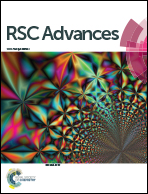Green silver nanoparticles for drug transport, bioactivities and a bacterium (Bacillus subtilis)-mediated comparative nano-patterning feature†
Abstract
The ‘green’ synthetic aspects of functionally potent and biologically relevant nanomaterials are a crucial research objective. Pursuing this concept, we have investigated a green synthetic scheme for the sunlight-mediated generation of luminescent silver nanoparticles, which become stabilized via a supramolecular hydrogel (SHGel) network, as already reported by our group. In vitro and in vivo toxicity studies confirm the biologically relevant nature of SHGel-capped Ag NPs. Nontoxic SHGel-capped Ag NPs were intelligently used for the transport of drugs, including antifilarial and antibiotic agents, into cells. Apart from this activity, SHGel-capped Ag NPs and our previously reported nontoxic DNA hydrogel-capped Ag NPs are potent against pathogens and parasites. Most interestingly, the nanostructural patterns of SHGel- and DNA hydrogel-capped Ag NPs have been transformed into cotyledon- and flower bud-shaped forms of nanosilver, respectively, during their chemotherapeutic action against a particular bacterium, Bacillus subtilis. Transmission electron microscopy was used for the visualization of several patterns of nanosilver and the incorporation of Ag NPs into macrophages.



 Please wait while we load your content...
Please wait while we load your content...